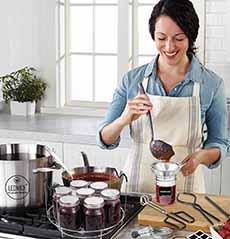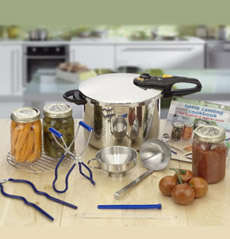Home Canning For Fun & The History Of Canning
|
Editor’s Note: Fagor America, whose canning product is featured in this article, ceased operations in 2018. However, the majority of the article is still relevant to home canners. You can find numerous other brands of home canning kits. Plus, enjoy the history of canning, below. If you love to cook and teach your family how to prepare healthy food, consider taking up home canning. It’s an enjoyable family activity, and become a summer tradition in your home. You can prepare batches of delicious soups, vegetables, pasta sauces and fruits to recall the summer bounty during the bleak winter months. Your canned foods can also be special holiday gifts; or you can make baby food as gifts for new parents. Kids will enjoy learning how preserve their favorite fruits and parents can feel good about giving them an empowering kitchen skill. If you haven’t done canning before, Fagor America makes a Duo 9-Piece Pressure Canning Set, with all the equipment needed to preserve your favorite foods, except the glass canning jars. > February 1st is National Canned Food Day. There’s quite a selection of home canning kits, which range from $20 and up. More expensive kits include a large, heavy-duty pot. The set originally featured in this article (no longer available), the Fagor 10 Quart Duo Pressure Cooker/Canner, had a full color cookbook containing all the necessary preparation instructions and recipes for home canning, and the canning tools: canning rack, jar wrench, jar lifter, funnel, magnetic lid wand, ladle and bubble freer. |
|
|
|
It was a deluxe set. The manufacturers suggested retail price (MSRP) was $129.99 at Bed Bath and Beyond and Sur La Table. If you already have a pressure cooker, the other kit elements are just $29.99 on Amazon. Quart-size Mason jars are $20.99 per dozen; pint jars are $14.17. There are also half gallon jars. The pressure cooker can also be used daily to cook a variety of healthy meals in super-quick times (up to 70% faster—short ribs in 45 minutes instead of 5 hours, for example [more about pressure cookers]). |
||
 [3] A simple solution to preserve food: It only took 14 years of experimentation for Nicholas Appert to come up with the basic principle (photo © Ahmed Al-Shukaili | Stock Xchange). |
CANNING: AN OVERVIEW
Canning is the method of applying heat to food in a closed glass canning jar or a metal can, to kill the bacteria and stop the natural spoilage that would otherwise take place. The process also removes the air from the jar to create a seal so new bacteria can’t grow. The procedure uses fresh, seasonal fruits and vegetables when they are at peak, with the most vitamins and nutrients. The We take canned food for granted, but it is a relatively recent invention—and we owe it to Napoleon Bonaparte. In his time, food preservation was basically limited to salting, drying, and pickling, techniques that had existed for thousands of years. Needing a better solution for his troops, in 1795 the French general, known for declaring that “an army marches on its stomach,” got the French government to offer 12,000 francs to anyone who invented a new way to preserve food. |
|
|
The prize was ultimately won by Nicholas Appert, a chef, confectioner, and distiller, who began experimenting when the award was announced and finally submitted his invention 14 years later, in 1809. Appert hermetically sealed food in airtight glass jars and heated them—a method similar to today’s home preserving in Mason jars. Appert thought that driving the air out of the containers prevented the spoilage, but 100 years later, Louis Pasteur showed that it was the elimination of bacteria through sterilization that did the trick. Napoleon tried to keep the new process a secret so that enemy armies would not have the advantage, but the word leaked out. Appert’s method was so easy that it quickly became widespread. The following year another Frenchman, Pierre Durand, patented a method using a tin container; the lighter, breakage-proof tin cans would become the norm. In 1812, an English company purchased both patents and began producing canned preserves. Canning emigrated to America, where canneries began to preserve seasonal foods and perishables; but most Americans still cooked from fresh and dried staples, and canned food did not become the everyday food delivery system we known until the beginning of the 20th century. Appert, known as the “father of canning,” also invented the bouillon cube. More about home canning from Ball, a producer of Mason jars. CHECK OUT WHAT’S HAPPENING ON OUR HOME PAGE, THENIBBLE.COM.
|
||




